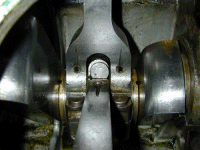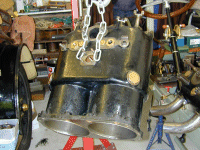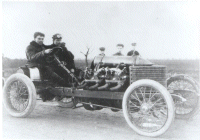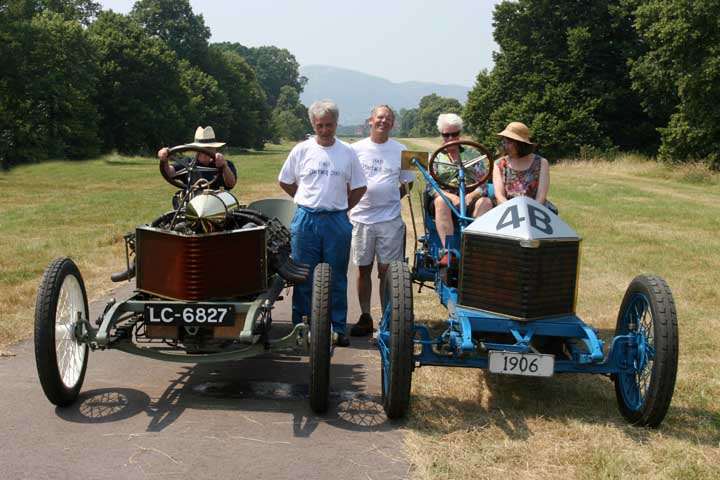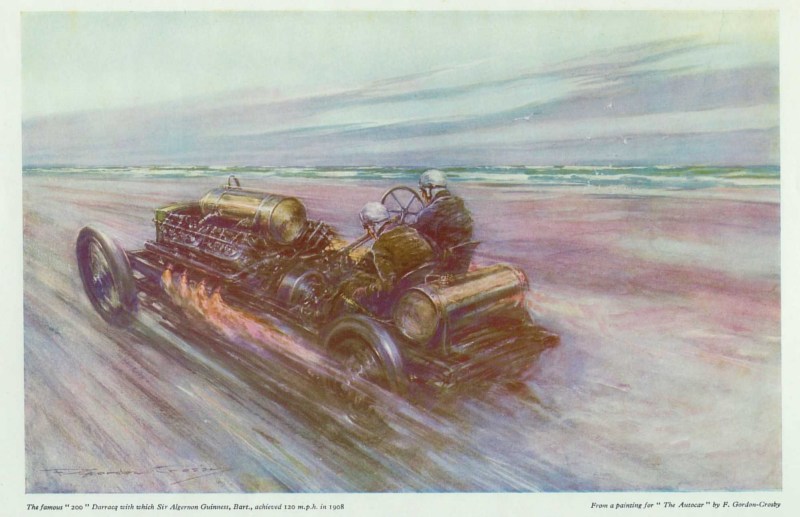www.darracq.info
v2.3 December 2023
Site rules, contact, cookies, and privacy
The Darracq V8 1905 - 2005 centenary
"Old Iron" - a story of the Darracq 200
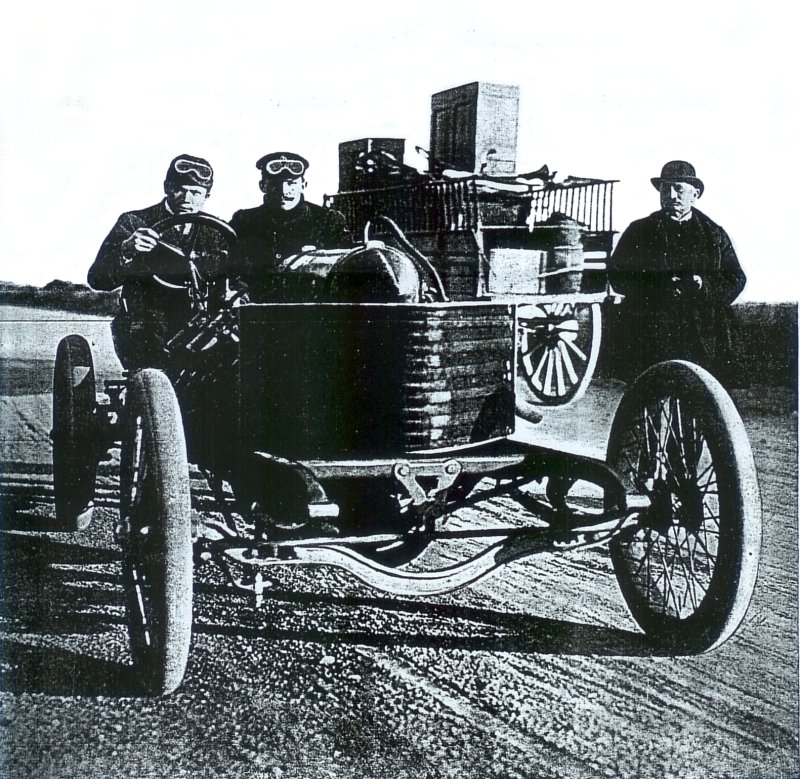
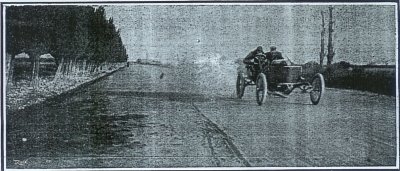
Words by John Wood based on material referenced at bottom
Photos by John Wood and family archive
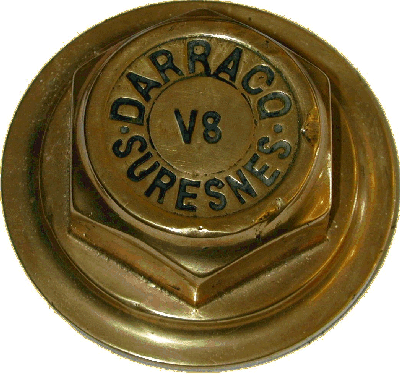
|
Technical comments
Gallery of rebuild photos
Gallery of period photos
| 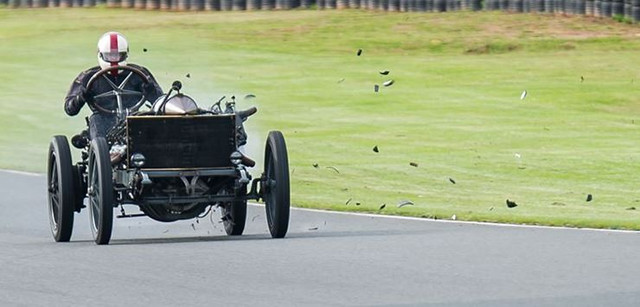
From Mallory Park destruction
now repaired for 2020 action at Goodwood
see S.F.Edge trophy race on Youtube
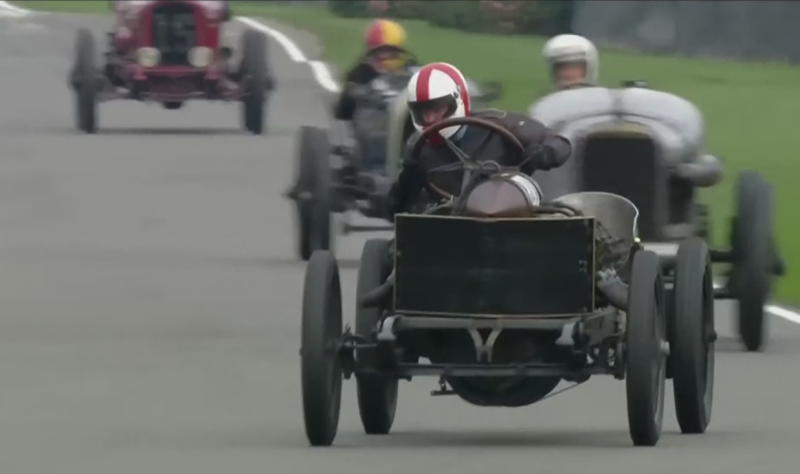
|
|
|
This site documents the rebuilding of this historic and unique car during the latter half
of 2005 in time for its 100th birthday, and the anniversary of its successful attack on the World Land Speed record.
During 2006 it was fired up and driven a number of times.
The above is a photo of the car waiting to make its run in 1905, notice the dirt road surface and a picture
from the archives showing these brave men in action on 30th December 1905.
The star of this story is the V8 engine itself, designed by Ribeyrolles and built in 1905
solely to take the land speed record. The human star is not Mr Darracq himself but the mechanic
for the Darracq company, Mr Victor Demogeot, seen as the mechanic in the picture above.
In 1904 the Darracq Company had determined to build three racers for the Gordon Bennett Cup race of
that year, and Victor Hemery had joined the Company as the chief tester.
Victor Hemery was first paired with his mechanic Victor Demogeot on the 16th June 1905 for the Gordon Bennett
Cup french trials, later they contested the important 590Km race in Belgium on 7th August 1905 at Circuit
Des Ardennes which they won in their 80hp Darracq four cylinder against stiff opposition.
A similar Darracq driven by Paul Baras held the land speed record at 105 mph.
The factory desperately wanted to retain the record wining performance, and Hemery's view was that an
engine of twice the size should easily be able to lift the land speed record to a new level.
George Cook, who was the American president of Darracq USA, tried to impress on the factory the importance
of the Vanderbilt Cup. On 14th October 1905 the pair won the Vanderbilt Cup held on Long Island USA.
It was here at Long Island that Hemery and Demogeot met Louis Chevrolet, the most important french speaking
driver on the race circuit. Chevrolet was driving for Fiat and Christie at the time. Just for the record,
the Christie car was front wheel drive, and the Darracq race cars had over-square engines typically at
160mm bore by 140mm stroke (not much is new in car design in the last 50 years, just refined!)
The designer Ribeyrolles could not stay within the weight limit by having two straight four's so he built
a 90 degree V8 on a common crankcase using just one four cylinder crankshaft and camshaft. He used the same
valve gear as had been successful on the 1904 100hp Darracqs and took the bore out to 170mm to make a very
over-square motor at 170x140. This engine was rated at a nominal 200hp with a displacement of 25422 cc.
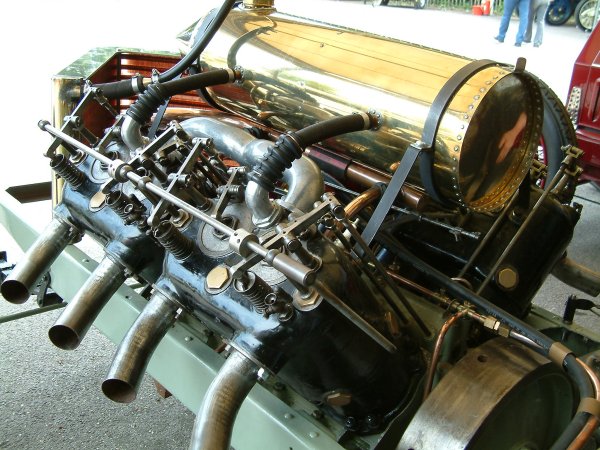
| The V8 engine as displayed at Goodwood in 2005
| 
|
The crankcases were made of alloy and the bifurcated con-rods allowed the pots to be opposite each other.
Ignition was by a Nieuport magneto and each bank of four cylinders was fed by a Darracq carburettor,
the radiator was a distinctive D or V shape by Grouville and Arguemborg, the frame was pressed steel by Arbel.
The fuel was supplied from a small round tank behind the driver's seat under pressure from an air pump located
beside the mechanic's seat.
The car was eventually finished in December 1905 and the 990Kg special was delivered to the ACF inspection
team in Salon-en-Provence together with the crew, Hemery and Demogeot.
The car speed was measured between milestones 49 and 50 on the Salon to Arles dirt road.
The records show four runs, 21.8 secs 20.6 secs 20.8 secs and 20.6 secs for the flying kilometre,
a world record of 109.65 mph.
Hemery considered that the very cold weather had a poor effect on the carburation, and that future records
would be broken. The car was immediately shipped to America for the Ormond Beach Speed Tournament at Daytona
held on 20 - 27 January 1906.
Daytona provided up to 23 miles of hard packed sands over 500 feet wide at low tide.
It was also bordered on the shore side by a continuous run of tufted grass
dunes providing ideal spectator viewing. Although the length of beach seem to make Daytona
ideal, its condition is dependent on the weather and the last tide. The weather conditions
as the tide goes out determine the shape and distribution of the ripples on the surface.
The Atlantic rollers may pound the beach creating deep gullies.
Motor Age reporting on 1st January 1906 lays out the challenge.
"A special cable from Paris states that the Darracq 200 has broken the flying kilometre.If
the Hemery record is correct, then the Darracq is a full 4 seconds faster than the Napier to
the mile, considering the advantages of the beach, the probability of the Darracq being on
demonstrable form to turn the trick, however hinges on the authenticity of the report.
Betting is now even whether the 2-miles-a-minute will be broken."
The tournament competitors were greeted with sunny skies and warm weather at the start of the week,
but as soon as racing began the bad weather started, chilling winds and storms
accompanied by abnormally high tides which engulfed the beach. Coordination between officials
was disgracefully lacking reported Motor Age at the time. All spectators left in disgust
due to poor weather and no racing.
On 23 January Marriott drove the twin engined steam powered Stanley streamlined car at 111.80 mph to win
the Dewar's Cup. Victor Hemery set a new world record that same day, the raised his own record of 109.25 mph
to 115.30 mph. Hemery had recently been barred from competing in Italy for offensive behaviour, and as the
Stanley and the Darracq came to the line for the elimination trials, Hemery revved the V8 and the flames
from his open exhausts blasted the wood and canvas body of the Stanley. Hemery was threatened with
disqualification, but the officials did not understand the stream of abuse in French that was his reply.
On 24 January 1906 the works driver Hemery elected to run during a break in the weather, but the timing
mechanism failed. Hemery was justly outraged at this incompetence, and furiously swore at the officials.
For this he was banned from the event. The fiery Hemery had several more altercations with authority later
in the year and was fired by the Darracq factory.
Motor Age reporting in 25 January 1906 sets the scene.
"Hemery, successor to the great Thery, has been given a taste of American discipline,
which will do his peppery temper good. He had a close call yesterday from being set down,
and this was not enough for him, for he broke loose again today and got what was coming to
him and he got is good and plenty, nothing less than disqualification for the entire
meeting for refusing to obey orders."
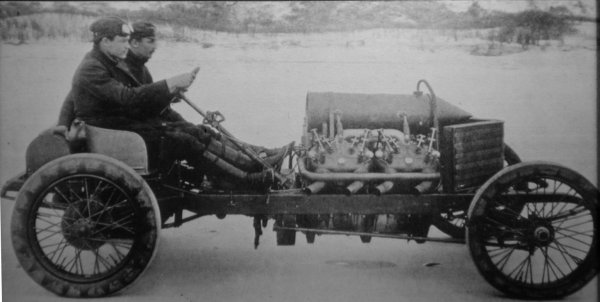
| A lovely period shots of the motoring heroes, above are Hemery and Demogeot, on the sands at Daytona getting ready,
and below are the victorious Demogeot and Vivet, they can hardly believe their good fortune
|
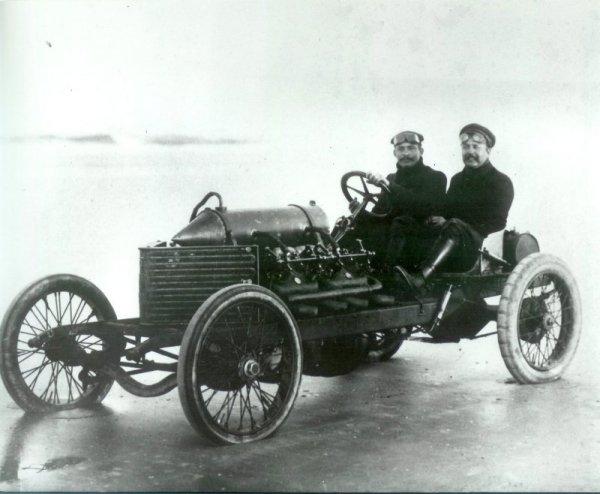
| 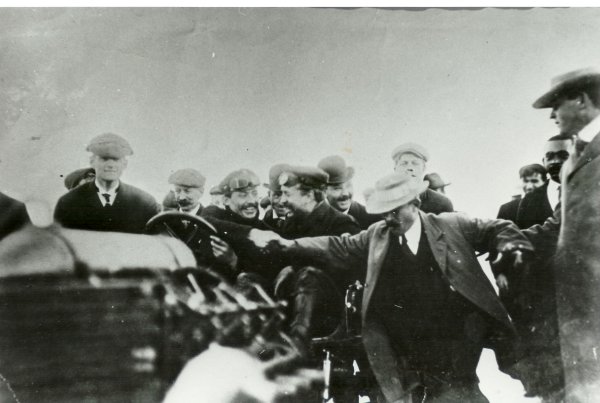
|
Following the banning of Hemery, the American agent George Cooke was given full control,
and he charged Mr S.B.Stevens to manage the team. Stevens took over the Darracq garage and
placed a guard on the door in case Hemery should try sabotage. and it was Stevens who engaged
Chevrolet to drive the "200". The third day dawned worse than before, not only was it damp
dirty an discouraging but it was raining hard. The tide was abnormally high due to the wind
and the storm, so it was not until the afternoon before the beach course was ready.
The following day, the ex-Christie team driver Louis Chevrolet drove the Darracq 200 and
took 117.65 mph with a time of 30.6 seconds. Undaunted by these events, Marriott set a new
speed record on 26 January 1906 of 127.66 mph in a time of 28.2 seconds, however only his
slower speed for the flying kilometre (121.57 mph) was officially recognised in Europe.
On the final day came the event which had drawn the largest crowd of the week. The paper
had run a competition for the prettiest girl in Florida to present the "golden crown", special
trains had been laid on from Jackonville, the grandstands were full to overflowing. The event
was a "2 miles in 1 min" competition for a gold crown. Chevrolet would not drive again except
for an substantial additional fee, so the Darracq mechanic Demogeot was pressed to task,
now partnered by Vivet. He did a best of 122.4 mph with a time of 58.8 seconds, a fabulous
time. The prettiest girl in Florida, Miss Mary Simrall, crowned Demogeot the "1906 Speed King"
but it was done with a laurel wreath, no golden crown ever materialised. The car was returned
to the factory in the Suresnes district of Paris. Chevrolet might have been mercenary,
but he was a fearsome driver, and lucky too. He survived many crashes, spent three years in hospital
between 1905 and 1920, and killed four mechanics. These are not romantic days!
In June 1906, following the publicity of the world records, the car was bought by Algenon
Lee Guinness (ALG), who went on to become a director of the Sunbeam Talbot Darracq company.
It appears (according to H W Bunbury) that Lord Annesley persuaded ALG to buy the car "which
was then in Oxford Street to which they then proceeded in His Lordship's unsilenced Mercedes
Sixty. They found the car in a basement where it was started up, it created an inferno of
noise smoke flame and fumes. His Lordship was delighted and it certainly impressed Algy
considerably. His agreement to buy coincided with the arrival of a policeman to see what the
noise and fuss was about, and the 200 was towed to Dachet behind the Mercedes. The Guinness
brothers used to test it at Hartford Bridge Flats near Camberly with friends and police
guarding the side roads", where it was possible for the mechanic to time the car over a flying
kilometre between two markers. In 1906 ALG did 117.7 at Ostend speed trials, and gave a
demonstration run at Skegness where poor weather precluded any fast times.
"For a real thrill and for pure joy, nothing ever came close to a full throttle run on the
200 in the car in Algy Guinness' capable hands. 'Old Iron' as its owner christened it, was
definitely one of the great cars of all time" said Bunbury.
Another article reported that the car was returned to Suresnes in Paris where ALG went to
visit it. He was given a trial run round the works by Hemery, and subsequently bought it
from the factory. It was brought over to Winsor, where it joined the garage with a Darracq 90
and Darracq 100. ALG is reported to have said later that he could only get 110 mph out of it.
However, he did manage 118 mph at Ostend and 122 mph at Saltburn so it cannot have been too bad.

| Algenon Lee Guinness standing in front of the "200", Saltburn Sands near Redcar in 1907-9.
On the left is his brother Kennelm Lee Guinness, who was regularly his mechanic.
KLG invented the KLG sparking plug, and as a driver in his own right was timed at Brooklands
in 1921 at 144 mph in a V12 Sunbeam. His official 137.15 mph flying kilometre record in 1922 was
to stand unbeaten for another seven years.
|
In 1907 the American Dugal Ross tried to buy the car, and was shown a demonstration run at Brooklands
of 115.4 mph, he was subsequently too frightened to complete the £2000 deal. That Guinness sold the car
to Oscar Morris who installed a 8L Daimler engine is probably untrue since the car definitely went to a
car dealer/scrap merchant and was cut up, the central section of the chassis stayed with the engine which
is what Gerald Firkins bought in 1956.
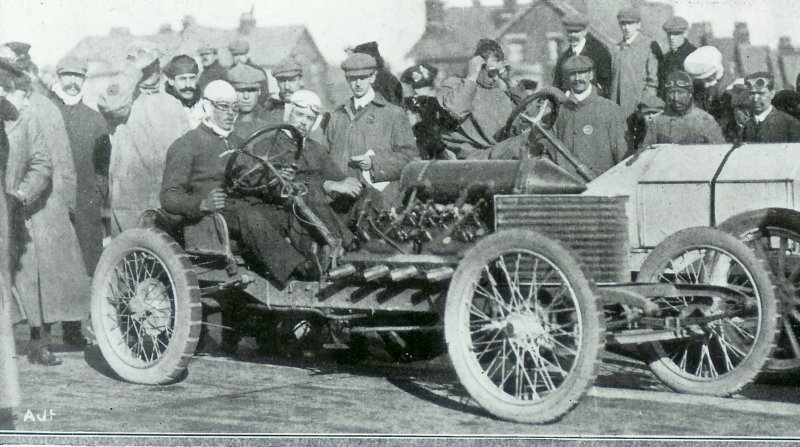
| Algenon and Kennelm Guinness ready for action at the Blackpool meeting 1906
|
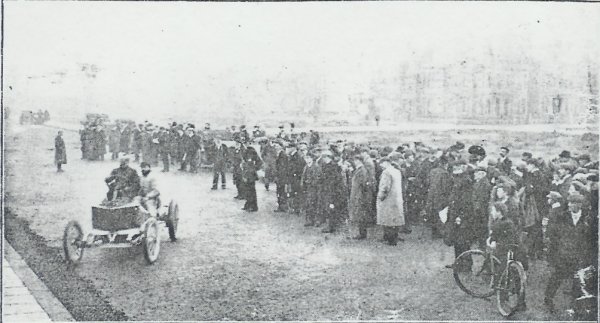
| Algenon and Kennelm Guinness at the start on the South Shore Blackpool
|
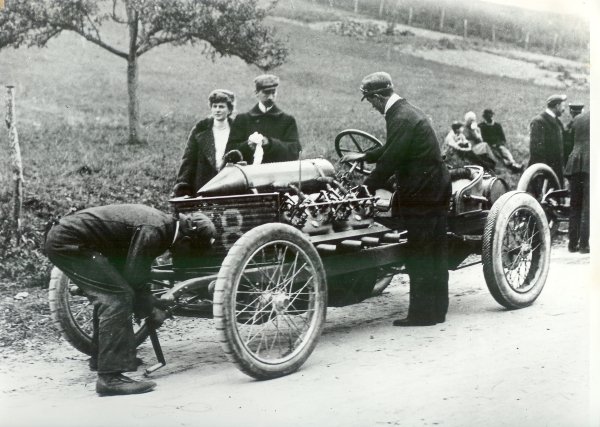
| ALG and the "200" at Gaillon Hill Climb
| 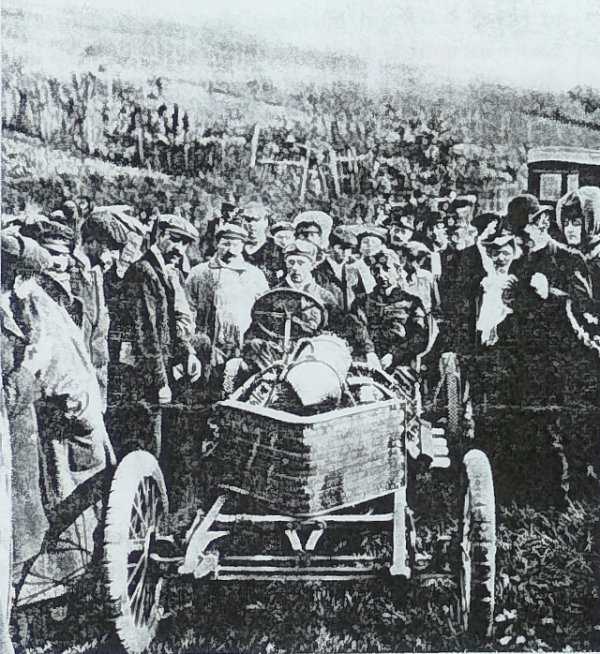
|
| At the Gaillon Hill Climb in 1907 when ALG put up a best time some 40 mph
faster than the second placed car, the relegated Frenchman enforced an old rule that the cars
were supposed to have a reverse gear. Of course the "200" did not have any such thing, and the
officials disqualified ALG, well it was a Frenchman complaining in France.
His reply, with all the flippancy of an Irishman, was that he had come to the event forwards
and had left the reverse gear at home. He offered to go back and get it!
The officials agreed that he could do that and represent the car the next morning. He went to
the nearest blacksmith and had made a bracket and spindle, on the spindle was a roller 2"
long by 0.5" diameter. He re-adjusted the clutch so that it came back a long way and left
enough space to insert the roller. The inserted roller would now have the clutch plate driven
by the flywheel in the reverse direction. It is just possible to see this reverse gear apparatus
on some pictures. In the morning the car was presented to the officials, the motor running
and the clutch pushed out as far as it would go. The roller was inserted and ALG shouted
"Gentlemen, tell me when to go!". As the 18" clutch went in, with a bang the car leapt
backwards two or three metres scattering officials and spectators alike. He was reinstated winner immediately.
The photos above show ALG and KLG at Gaillon 22 October 1906. A week later on 28 October 1906 the Guinness brothers were in action at Dourdan,
a few miles south west of Paris. They took the honours again.
| 
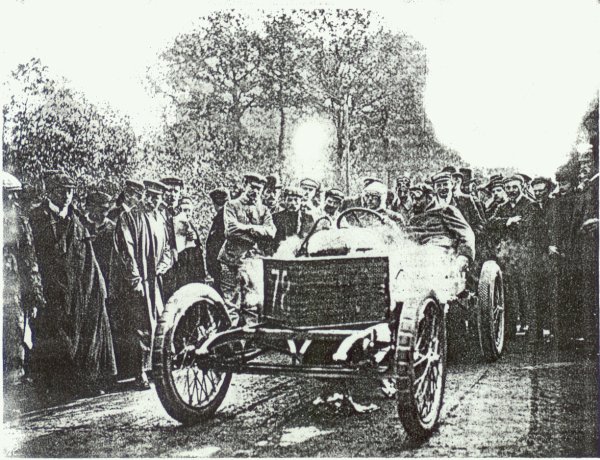
|
The St. Barbe Hill climb at Gaillon was always popular with spectators, north of Paris and easy access from
Rouen, it always attracted some 1000's of spectators. The Autocar of 1906 reports " The [previously
successful] six cylinder Napier however found a formidable competitor in the 200hp Darracq which flew up the
hill in a marvellous time of 25 secs thus beating the existing record held by Barras (Darracq) and Rigolly
(Gobron-Brillie). Among the light cars, Demogeot did a FTD time of 29 secs."
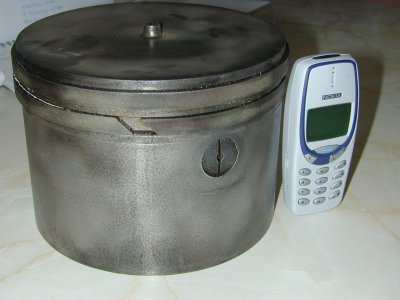


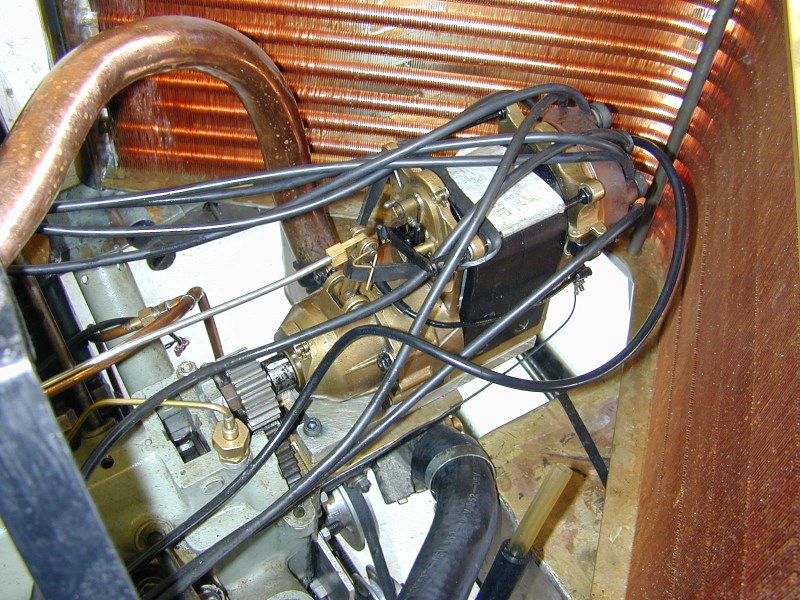
ALG used the car extensively over the next few years until its final run on 26 June 1909 when it set a
British record of 193 Km/hour for the flying mile. Following such a run it was ALG practice to inspect
the engine, and on this occasion a cracked No 6 piston was discovered. You can see the crack below the
gudgeon pin. See also the troublesome magento that caused me so many headaches.
The car seems to have disappeared
from competition at this time, although ALG continued to use four cylinder Darracqs in many competitions.
ALG frequently competed at Saltburn Sands in Yorkshire. He attended the meeting reported by Autocar on
4th July 1908 where ALG returned a new record of 121.6 mph for the flying kilometre beating a previous
British best of 111.84 mph.
Several years later, Lady Guinness complained loudly (that's ALG's mum, Mum's do that) about the junk,
and he was to take it to the scrap immediately. This he did! He binned it!!
A few years later he regretted this mad action and was subsequently able to retrieve the engine from the
dealer, but it was never to run again. The dealer had cut the front axle and rear axles off the chassis,
so it was only the central braced engine section that remained. It remained in ALG's garage until he died
in 1954.
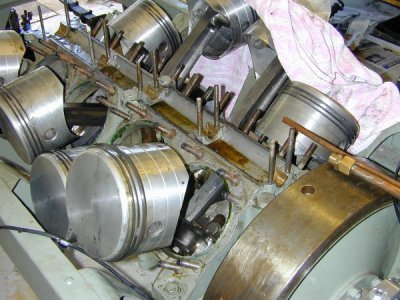
|
Gerald Firkins knew of the car and was a Darracq collector himself, and was
able to purchase the engine from the family in 1956. It sat in Gerald's garage for many years until a
slow restoration started.
The renovation has been time consuming, not least the making of 8 aluminum pistons to
replace the cast iron originals in 1991. There was one cast iron piston missing from the set when I started the rebuild.
They were made by the Pearson family from Knowle and Sheldon Birmingham, local to myself, so I went to see if they were still about,
found the last remaining son and he had kept the piston given to them as a sample, and could not bring it upon himself to throw it away.
It was still there at the back under his dad's old work bench, and he gave it to me. This is the piston which you see in tghe picture above.
The crankshaft and con-rods and camshaft are all original and in surprisingly good condition, and the condition of the big-ends
and mains attest its relatively low mileage.
It was a sprinter and probably never ran for more than 10 mins at a time, and that includes warming up.
|
| | Records
|
| 1905 December 30 | world land speed 109.65 at Arles, France (Hemery, Demogeot)
|
| 1906 January 25 | American record 117.64 at Daytona (Chevrolet, Demogeot)
|
| 1906 January 29 | world record at Daytona 120.40 (Demogeot, Vivet)
|
| 1906 July 14 | Ostend speed trials European flying kilometre record 117.7 (A Lee Guinness)
|
| 1906 September 08 | Skegness - demonstration run
|
| 1906 October 13 | Blackpool world record standing kilometre 32.4 secs
|
| 1906 October 13 | Blackpool world standing mile 45.6 secs
|
| 1906 October 13 | Blackpool British flying kilometre 21.0 secs 106.52 mph
|
| 1907 June 16 | Scheveningen speed trials world record standing kilometre 33 secs
|
| 1907 June 22 | Saltburn speed trials Yorkshire record flying kilometre 111.84 mph
|
| 1907 September 20 | Brooklands fasted recorded speed 115.4 mph
|
| 1907 November 03 | Gaillon (St. Barbe hillclimb) record 25.0 secs
|
| 1908 June 28 | Saltburn British & European record flying kilometre 121.57
Equals world record
|
| 1909 June 26 | Saltburn FTD flying kilometre 120.25
|
Other Results
|
| 1906 October 22 | Dourdon France, standing mile FTD 47.4 secs 75 mph
|
| 1906 October 22 | Dourdon France, flying kilometre FTD 20.0 secs 111.85 mph
|
| 1906 October 28 | Gaillon (St. Barbe hillclimb) FTD
|
| 1906 November 4 | Benoite Hill Climb, France FTD 60.4 secs 74.07 mph
|
| 1907 ??? | Fromes Hill Climb, Herefordshire FTD
|
| 1907 September 07 | Brooklands, 1/4 mile record
|
FTD = fastest time of the day
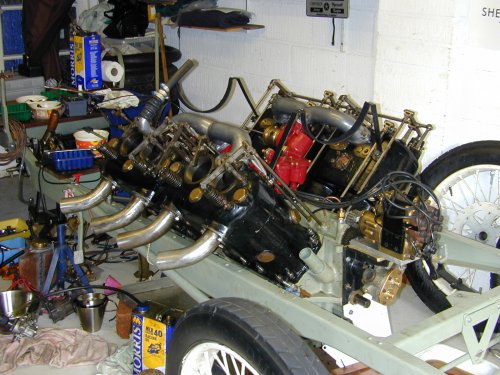
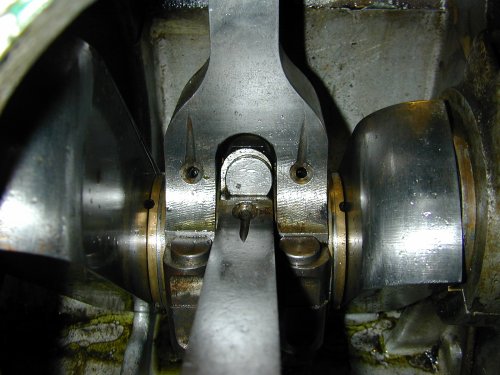
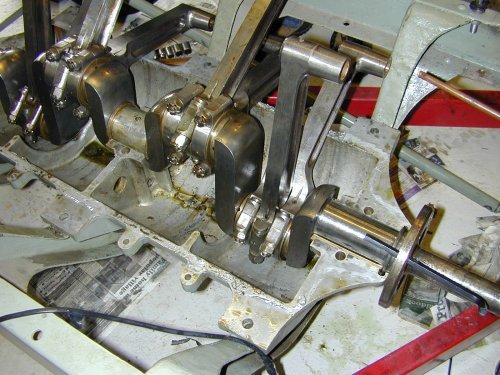
Where did the 200 race
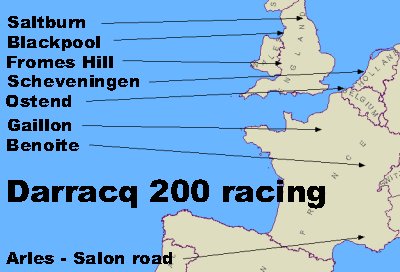

| 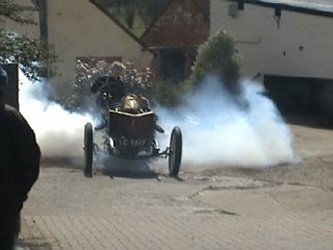
| 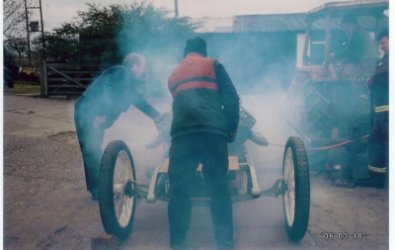
|
| Tractor PTO required this time
| making smoke
| making adjustments
|
References
Under My Bonnet hardback book by Minchin
Monochrome photos from the Firkins family archive, National Motor Museum, and Griffith Borgeson
Photo copyright: Colour photos by author, and Firkins family archive
Autocar magazine, Vintage and Thoroughbred magazine
Racing on the Rim, book by Dick Pinnett (racing at Daytona Ormond Beach, USA)
A Dash Between The Tides, book by Ernie Crust (racing on Redcar sands, Yorkshire)



